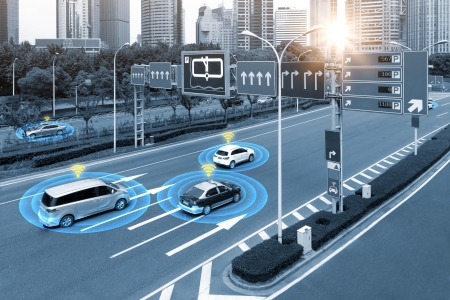Reactions of fellow road users to self-driving vehicles seem to differ from their reactions to conventional vehicles. Research in this area is limited, however, and there is much that we do not know yet. Below, we discuss the current findings, first for vulnerable road users, and subsequently for drivers of conventional vehicles.
Vulnerable road users
Cyclists and pedestrians are as yet unsure whether self-driving vehicles will see them and will stop for them [45]. It comes as no surprise, therefore, that vulnerable road users seem more conservative in crossing the road when a self-driving vehicle approaches than when a conventional vehicle does [46] [47] [48]. Good communication of the vehicle with vulnerable road users about its intentions (I am driving on, I am going to stop) may ensure that vulnerable road users will cross the road more easily and more confidently [49]. This kind of communication will be further discussed when answering the question How can self-driving vehicles, drivers and other road users communicate?
Several studies suggest that cyclists and pedestrians adapt their behaviour based on previous experience with self-driving vehicles [28] [46]. Thus, it has been shown that cyclists are more positive about a self-driving shuttle if they have dealt with it before, but that they are, then, also less inclined to yield right of way to such a vehicle [28].
Drivers of conventional vehicles
Research into how drivers of conventional vehicles react to self-driving vehicles has focused on platooning trucks, or automated trucks that drive very closely together (see the question How safe are platooning trucks?). Drivers of conventional vehicles appear to feel less comfortable and safe, and more stressed, in proximity to platooning trucks [21]. Moreover, drivers may adapt their behaviour by reducing their own distance to the platooning trucks [50]. as well. Risks when overtaking were also observed (see the question How safe are platooning trucks?). Yet, another study finds no difference between driver behaviour when platooning trucks versus non-automated trucks are overtaken [21]. Whether drivers of conventional vehicles do or do not merge with platooning trucks depends on the extent of the distance between the trucks, implying that drivers are less inclined to overtake if the distance between the trucks is shorter [21].
In a US study [51] datasets of crashes involving self-driving vehicles have been analysed. The study shows that all self-driving vehicle crashes belonging to the dataset were crashes with other, conventional vehicles. Of course, conventional, non-self-driving vehicles crashing with other vehicles also regularly occurred (68%), but they included collisions with stationary (16%) and non-stationary objects (14%), or crashes without any collision (2%). The researchers suggest that self-driving vehicles do not seem to be responsible for the crashes they are involved in, but rather the drivers of conventional vehicles. They think a possible explanation of this finding is that drivers of conventional vehicles feel unsure of what to expect from self-driving vehicles. Yet, the causes of crashes with self-driving vehicles are probably complex and cannot be attributed to a single factor. Thus, there are also challenges for users of self-driving vehicles (see the question What driver-related obstacles are involved in self-driving cars?) that could be at play.
